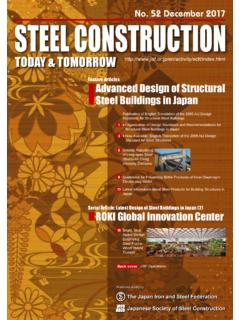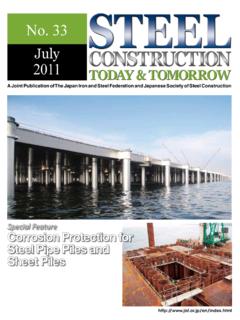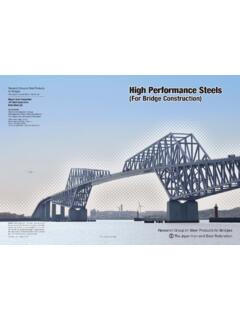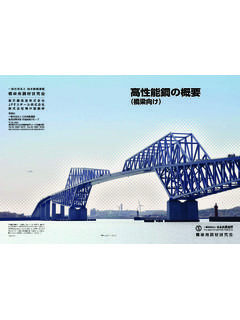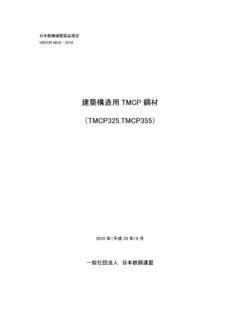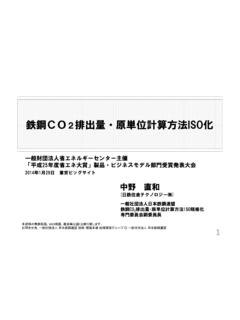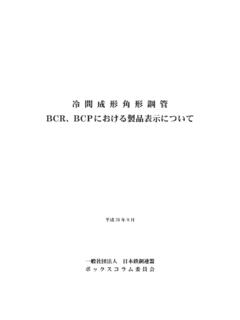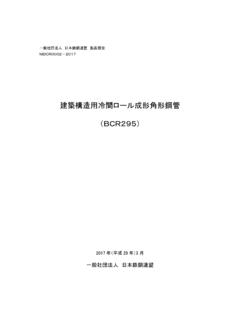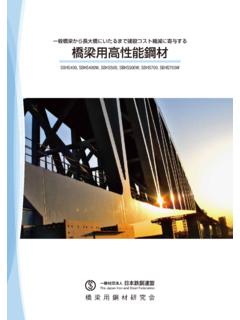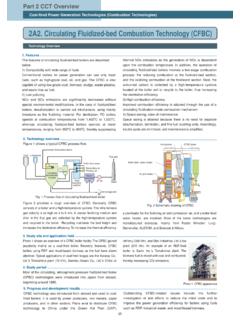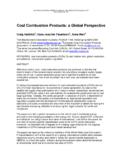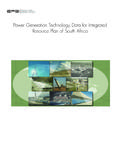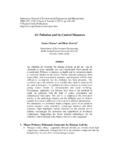Transcription of The State–of-the-Art Clean Technologies (SOACT) …
1 The State of-the-Art Clean Technologies (SOACT) for steelmaking handbook (2nd Edition). Raw materials through steelmaking , including Recycling Technologies , Common Systems, and General Energy Saving Measures Asia Pacific Partnership for Clean Development and Climate December 2010. Acknowledgment In support of the goals of the Asia-Pacific Partnership on Clean Development and Climate, this work was financially supported by the State Department through IAA number S-OES-07- IAA-0007 and the Department of Energy's Industrial Technologies Program through Department of Energy Contract No. DE-AC02-05CH11231. Disclaimer This document was prepared as an account of work sponsored by the United States Government. While this document is believed to contain correct information, neither the United States Government nor any agency thereof, nor The Regent of the University of California, nor any of their employees, makes any warranty, express or implied, or assumes any legal responsibility for the accuracy, completeness, or usefulness of any information, apparatus, product, or process disclosed, or represents that its use would not infringe privately owned rights.
2 Reference herein to any specific commercial product, process, or service by its trade name, trademark, manufacturer, or otherwise, does not necessarily constitute or imply its endorsement, recommendation, or favoring by the United States Government or any agency thereof, or The Regents of the University of California. The views and opinions of the authors expressed herein do not necessarily state of reflect those of the United States Government of any agency thereof, or The Regents of the University of California. Ernest Orlando Lawrence Berkeley National Laboratory is an equal opportunity employer. The State of-the-Art Clean Technologies (SOACT) for steelmaking handbook (2nd Edition). Asia Pacific Partnership for Clean Development and Climate Prepared for the Asia-Pacific Partnership on Clean Development and Climate, United States Department of State, and United States Department of Energy Prepared by Lawrence Berkeley National Laboratory Berkeley, California American Iron and Steel Institute Washington, DC.
3 Table of Contents Introduction .. 1. Steel Production Basics .. 3. 1 Agglomeration .. 5. Sintering .. 5. 5. 5. 2 6. 3 Ironmaking .. 1. Blast Furnace .. 2. Direct Reduction .. 3. Direct Ironmaking .. 4. Smelt Reduction Processes .. 4. Direct Reduction Processes .. 4. 4 steelmaking .. 5. Basic Oxygen Furnace (BOF) steelmaking .. 5. Electric Arc Furnace (EAF) steelmaking .. 6. 5 Ladle Refining and 8. Ladle Refining for BOF and EAF .. 8. 9. 6 Rolling and Finishing .. 11. Rolling and Forming .. 12. Finishing .. 13. 7 Recycling and Waste Reduction Technologies .. 14. 8 Common Systems .. 15. 9 General Energy Savings & Environmental Measures .. 16. 1 Agglomeration .. 17. Sintering .. 17. Sinter Plant Heat Recovery .. 17. District Heating Using Waste Heat .. 18. Dust Emissions Control.
4 19. Exhaust Gas Treatment through Denitrification, Desulfurization, and Activated Coke Packed Bed Absorption .. 20. Exhaust Gas Treatment through Selective Catalytic Reduction .. 21. Exhaust Gas Treatment through Low-Temperature Plasma .. 22. Improvements in Feeding Equipment .. 23. Segregation of Raw Materials on Pellets .. 24. Multi-slit Burner in Ignition Furnace .. 25. Equipment to Reinforce Granulation .. 26. Biomass for Iron and Steel 27. Exhaust Gas Treatment Through Additive Injection and Bagfilter Dedusting .. 28. 2 29. Super Coke Oven for Productivity and Environmental Enhancement towards the 21st Century (SCOPE21).. 29. Coke Dry 31. Coal Moisture 33. High Pressure Ammonia Liquor Aspiration System .. 34. Modern Leak-proof Door .. 35. Land Based Pushing Emission Control System.
5 36. Coke Plant Automation and Process Control 37. Heat-recovery (non-recovery) Coke Battery .. 38. 3 Ironmaking .. 40. Blast Furnace Ironmaking .. 40. Top Pressure Recovery Turbine .. 40. Pulverized Coal Injection (PCI) System .. 41. Blast Furnace Heat Recuperation .. 42. Improve Blast Furnace Charge Distribution .. 44. Blast Furnace Gas and Cast House 45. Cast House Dust 46. Slag Odor Control .. 47. Blast Furnace Increase Hot Blast Temperature (>1100 Deg C).. 48. Blast Furnace Increase Blast Furnace Top Pressure (> Bar Gauge) .. 50. Optimized Blast Furnace Process Control with Expert System .. 51. Alternative Ironmaking: Direct Reduction (DRI/HBI) and Direct Smelting .. 52. Smelting Reduction 52. Direct Reduction Processes .. 53. ITmk3 Ironmaking Process .. 54. Paired Straight Hearth Furnace.
6 55. Corex 56. Finex Process .. 57. Rotary Kiln Direct 58. Coal Based HYL Process .. 59. Natural Gas Based Zero-Reforming HYL 60. Coal-Based Midrex Process .. 61. Natural Gas-Based Midrex Process with CO2 Removal System .. 62. 4 steelmaking .. 64. MultiGasTM Analyzer - On-line Feedback for Efficient Combustion, .. 64. ProVision Lance-based Camera System for Vacuum Degasser - Real-time Melt Temperature Measurement .. 65. Hot Metal Pretreatment .. 66. BOF Steel making .. 68. Increase Thermal Efficiency by Using BOF Exhaust Gas as Fuel .. 68. Use Enclosures for BOF .. 69. Control and Automization of Converter Operation .. 70. Exhaust Gas Cooling System (Combustion System) .. 71. OG-boiler System (Non-combustion)/Dry-type Cyclone Dust Catcher .. 72. Laser Contouring System to Extend the Lifetime of BOF Refractory Lining.
7 73. BOF Bottom Stirring .. 75. Pressurization-type Steam Aging Equipment for Steel Slag .. 76. EAF steelmaking .. 78. Elimination of Radiation Sources in EAF Charge Scrap .. 78. Improved Process Control (Neural Networks) .. 79. Oxy-fuel Burners/Lancing .. 80. Scrap Preheating .. 81. New scrap-based steelmaking process predominantly using primary energy .. 85. Hot DRI/HBI Charging to the EAF .. 86. Control and Automation for EAF Optimization .. 88. Slag Foaming, Exchangeable Furnace and Injection Technology .. 89. Exhaust Gas Treatment Through Gas Cooling, Carbon Injection and Bagfilter Dedusting .. 91. ECOARCTM .. 92. 5 Ladle Refining and 93. Ladle Refining for BOF and EAF .. 93. 94. Castrip 94. Thin Slab Casting and Hot Rolling .. 95. Hot Charging to Reheat Furnace of Rolling 96.
8 6 Rolling and Finishing .. 97. 7 Recycling and Waste Reduction Technologies .. 98. Reducing Fresh Water 98. Slag Recycling .. 99. Rotary Hearth Furnace Dust Recycling 100. Activated Carbon Absorption .. 101. 8 Common Systems .. 102. Auditing Rotary Machines for Pump Efficiency .. 102. AIRM aster+ Software Tool Improved Compressed Air System Performance .. 103. Combined Heat and Power Tool Improved Overall Plant Efficiency and Fuel Use .. 105. Fan System Assessment Tool Efficiency Enhancement for Industrial Fan Systems .. 106. MotorMaster+ International Cost-Effective Motor System Efficiency Improvement .. 108. NOx and Energy Assessment Tool Reduced NOx Emissions and Improved Energy Efficiency .. 109. Process Heating Assessment and Survey Tool Identify Heat Efficiency Improvement Opportunities.
9 110. Quick Plant Energy Profiler First Step to Identify Opportunities for Energy Savings .. 112. Steam System Tools Tools to Boost Steam System Efficiency .. 113. Variable Speed Drives for Flue Gas Control, Pumps and Fans .. 116. Regenerative 117. 9 General Energy Savings & Environmental Measures .. 118. Energy Monitoring and Management Systems .. 118. Cogeneration .. 119. Technology for Effective Use of Slag .. 120. Hydrogen Production .. 121. Carbonation of Steel 122. Appendix 1. Summary Technologies Submitted ..124. Appendix 2. Extended Technology Information Provided ..138. Introduction The State of-the-Art Clean Technologies (SOACT) for steelmaking handbook seeks to catalog the best available Technologies and practices to save energy and reduce environmental impacts in the steel industry.
10 Its purpose is to share information about commercialized or emerging Technologies and practices that are currently available to increase energy efficiency and environmental performance between all the member countries in the Asia-Pacific Partnership on Clean Development and Climate. Steel is used in many aspects of our lives, in such diverse applications as buildings, bridges, automobiles and trucks, food containers, and medical devices, to name a few. Steel provides substantial direct employment in the Asia-Pacific Partnership on Clean Development and Climate (APP) countries, and provides a significant direct contribution to the APP economies. Countless additional jobs and economic benefits are provided in steel industry supply and support activities, including mining, capital equipment supply, utilities and many community industries.
